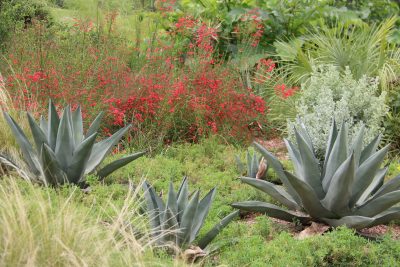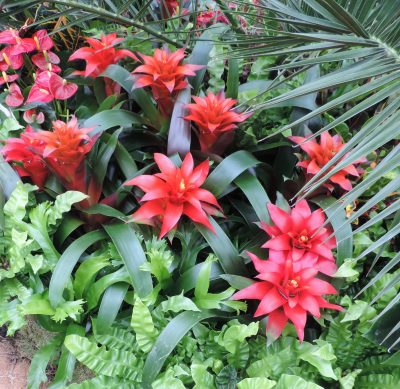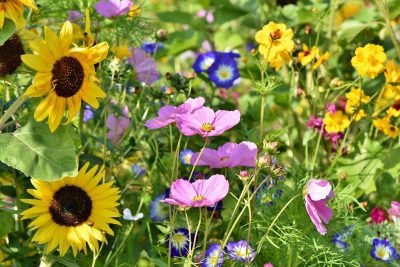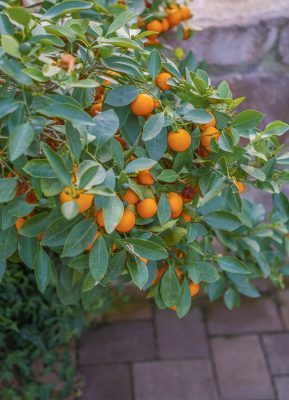Resilience is the word that seems to crop up in most garden trend predictions for 2024. But the mood is one of eco-optimism, and the desire to respond creatively to climate change.
Climate change is having a sobering effect on gardening. We are looking for plants that survive feast or famine, strategies for making every drop of water count and natural habitats that provide sanctuary for garden wildlife that is increasingly under pressure.
In their 2024 Garden Trends Report the Garden Media Group have coined the term eco-optimism. Led by Gen Z, there is a swing away from ‘climate doomism’ and an approach that sees climate change as ‘an opportunity to make meaningful change.’

We’re adapting … at every level of gardening, in our plant choices, garden styles, and how we garden. When choosing plants, labels count and words like heat or weather tolerant, low water use, disease resistant, non-GMO, pollinator friendly, make the sale.
A browse through Google offers plenty of creative ways to use less water and make every drop count. There’s a push to replace lawn with gravel, permeable paving, rainwater harvesting, and how to safely use grey water. Permaculture still leads the way with sustainable water use and re-use.
Extreme weather? Be prepared by stocking up with shade cloth for heat, frost cover for colder winters and tuning into the shifts of the seasons by adjusting sowing and planting times.

We’re planting … gardens with hardier plants like perennials, succulents and grasses as well as tropical plants that cope with heat and a shortage of water.
Tropical gardens have blossomed and one can only speculate that the popularity of indoor plants (mostly tropical) has something to do with it. Also, they are easy to maintain and are green all year round.
Large leaved plants like Delicious Monsters and Philodendron, are back in fashion, and the brilliance of coloured foliage plants almost makes flowers obsolete. With tropical plants there is ample opportunity to play with texture, form and colour. Many can start as indoor plants before graduating outdoors. There’s also the aspect of hardiness, such as bromeliads that multiply quickly. Cannas are also making a comeback and coleus too.
The design trend of naturalistic planting is gathering steam. It makes use of swathes of grasses and perennials that add movement, texture and colour, combining indigenous and exotic water wise varieties.
In South Africa, succulents should not be left out of the mix and thanks to them we have developed our own style of naturalistic planting, together with indigenous grasses and perennials such as agapanthus, wild irises, kniphofias, crocosmia, indigenous daisies, gaura, daylilies, and salvia.
While naturalistic gardens appear to be wild and free, they actually need careful planning and placing to achieve the desired effect. However, once established they are low on maintenance and sustainable, needing only to be tidied up in winter or spring. It’s all about diversity, working with nature and local conditions, letting nature take the lead. The fun part is when plants self-seed and each season brings new surprises.

We’re going vertical … with indoor plants that trail or climb. It could be that all available indoor table space has been taken, so we are left with air space. The bonus is that hanging plants are less likely to rot because of better air flow, and most are happy with minimal water.
One of the stars of trailing plants are our own indigenous senecio String of Pearls. Also look out for trailing monstera Adansonii and Siltepecana, as well as trailing philodendron Minima and variegated Hoya.

We’re nurturing … pollinators and garden wildlife, and although this has been on gardener’s radar for a while the threat to habitat posed by climate change, keeps this a priority.
And one can see this by the interest in naturalistic planting, the highlighting of bee friendly flowers and the move towards pollinator friendly organic and biological insecticides. The next time you visit a garden centre look out for pollinator plants like salvia, rudbeckia, buddleia, cosmos, yarrow, sunflowers, alyssum, single or double roses, lavenders…the list goes on!

We’re cultivating … edimentals, which is the term given to plants that are both ornamental and edible, such as the dwarf patio citrus, gooseberries, striking foliage plants like artichokes, rhubarb, and shrublike perennial herbs like lemon verbena, pineapple sage, rosemary and lavender.
The nice thing about edimentals is that they are mostly trees, shrubs or perennials which are hardier, and easier to look after than annual vegetables. From an aesthetic perspective they can be easily incorporated into a garden, adding texture, form and colour.
As you can see, plenty of room for eco-optimism!
Text: ALICE COETZEE


